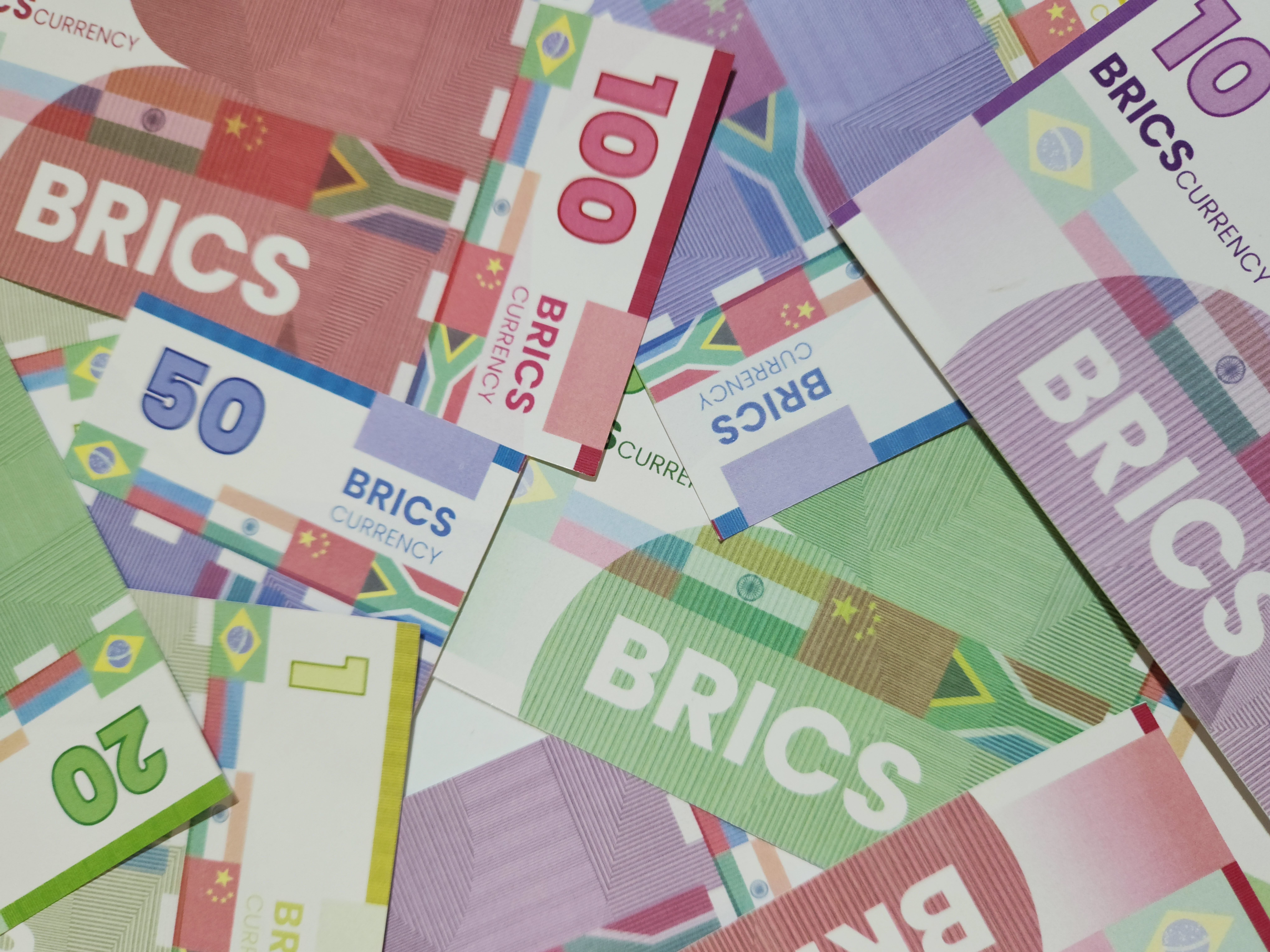The new year saw four of the largest economies in the Middle East and North Africa join the BRICS economic union. The accession by Egypt, Iran, Saudi Arabia, and the United Arab Emirates represents a strategic step away from the United States and Europe. For the new BRICS members, it could open new opportunities for trade and investment with the bloc’s founders. It may also offer them the opportunity to decrease their dependence on the U.S. dollar, giving them more flexibility to counter U.S. political and economic pressures. But while some BRICS officials have called for the bloc to wean itself off the dollar entirely, actually doing so would be arduous.
Understanding the Dollar’s Dominance
The U.S. dollar has served as the world’s primary reserve currency since the end of World War II. Under the 1944 Bretton Woods agreement, member states initially fixed their currencies to the dollar, the value of which was tied to gold. This brought stability to the global economy after the war. In 1971, however, the Nixon Administration abandoned the gold standard, unsettling the international economy by threatening to undermine the value of the dollar and the reserve holdings of many countries.
That was a particular concern for Saudi Arabia, which had priced oil exports in dollars since a 1945 agreement guaranteeing American access to Saudi oil in exchange for security guarantees. Having amassed dollar reserves, the Saudi Arabian government worked with the U.S. after the “Nixon Shock” to bolster demand for the dollar. Saudi authorities continued to price oil in dollars and successfully lobbied fellow OPEC energy cartel members to do the same. This buoyed the dollar at a crucial time, effectively tying its value to oil instead of gold.
Since the 1970s, the free-floating dollar has continued to serve as the world’s primary reserve currency, dominating international trade and banking, even as countries have adopted flexible exchange rates. U.S. treasury bills have also proven a dependable, low-risk investment. The depth of the U.S. financial system and the size and diversity of the U.S. stock market further bolsters demand for the dollar. Moreover, the dollar’s ready exchangeability has kept transaction costs low. Together, these factors have persuaded generations of policy-makers across the globe that the dollar is a reliable store of value.
Changing Perspectives on the Dollar
But while they value the dollar, central banks and fiscal policymakers have become increasingly concerned about their dependence on it. Concerns range from uncertainty about U.S. political stability and policy continuity to broader economic shifts related to great power competition. Mounting U.S. debt and domestic political contestation over budgets, debt limits and foreign policy are a headache for governments around the world. For developing economies, particularly those with fixed exchange rates, the strength of the dollar in recent years has weakened the competitiveness of exports and raised the cost of servicing dollar-denominated debt.
Central banks also fret over the “weaponization” of the dollar through U.S. economic sanctions. The U.S. has long employed sanctions as a foreign policy tool, seeing them as less costly and more humane than military intervention. Until recently, it had mainly used sanctions against pariah states, in cooperation with the wider international community, or against small, marginalized governments. Yet the Trump administration’s sanctions against Iran and President Joe Biden’s sanctions against Russia after the invasion of Ukraine have impacted more countries, more broadly. This includes European allies that had developed economic ties with Iran to support the 2015 nuclear agreement. It has also hit Saudi Arabia and the UAE, which had forged close ties with Russia and established the OPEC+ bloc to coordinate oil markets. As the U.S. economic relationship with China unwinds, many fear that the U.S. will employ sanctions to undermine its rival.
Given the ubiquity of the dollar, there are few ways for countries to circumvent sanctions once the U.S. has imposed them. Washington’s legal authority pervades the international financial system, from transactions involving its currency to U.S. nationals and businesses, U.S.-based assets, financial institutions located in the U.S. or with intermediaries in the U.S., and U.S. interbank payment systems. Wary of fines and of losing access to U.S.-based correspondent banks and interbank settlements, few international banks are willing to attempt to bypass sanctions, and Washington has been aggressive in prosecuting those who have. Because of the risks this poses to their own economies, central banks are looking for ways to decrease their dollar dependence.
Towards an Alternative
The BRICS countries arguably have the most to gain from replacing the dollar and have recently taken significant (if limited) steps away from the currency. China and India are seeking to build international demand for their own currencies. Like the U.S. before them, they have focused on the oil market, attempting to negotiate non-dollar oil sales with large producers both to guarantee their oil supplies and to bolster demand for their own currencies. China has focused on Saudi Arabia, seeking a deal for oil in renminbi during the 2022 Riyadh summit. In 2023, India signed an agreement with the UAE to explore pricing oil in rupees. That said, both Riyadh and Abu Dhabi are concerned about associated foreign exchange risks, transaction costs, and the convertibility of non-dollar holdings.
In August 2023, President Lulu of Brazil called for the establishment of a common BRICS currency. In theory, a currency union between BRICS countries, accounting for nearly a third of global GDP, would provide an attractive alternative to the dollar. However, establishing a currency union would pose a range of complex challenges. It would ultimately depend on BRICS countries developing a shared approach to economic policy, including agreements on debt and public spending limits. They would need to establish enough transparency around economic data and monetary policy to build trust among international investors and trade partners, factors that were essential in the dollar’s rise.
The founding BRICS countries are far from meeting these criteria. Brazil faces economic and political instability, and its currency has been devalued several times over the past few decades in the context of deindustrialization. Oil-dependent Russia has seen growth decline and will face more restrictions as war spending increases and sanctions bite harder. India is bound by rigid bureaucracy and popular resistance to market-oriented reforms, maintaining capital controls and often resorting to export restrictions to manage inflation. China has taken steps to ensure convertibility of the renminbi, but the economy is continuing to slow and a looming real estate shock could be contagious. Finally, South Africa is struggling with slow growth, high unemployment, weak infrastructure, and unsustainable public spending.
The new BRICS members do little to change this equation. Saudi Arabia and the UAE remain highly dependent on oil. Egypt faces an impending economic crisis, while Iran is struggling to emerge from a decade of slow growth that is further hobbled by U.S. sanctions. Ethiopia is embroiled in a civil conflict and broader economic instability.
None of these countries provide investors with the breadth and transparency of economic information provided by the U.S. government on the state of its economy. While the economic potential of BRICS countries is inherently attractive to investors, they do not provide the financial depth and market security offered by the American economy. Moreover, BRICS lacks a political or ideological foundation on which to cultivate coordination on the often contentious economic policies needed to maintain a shared currency. In fact, several of these states maintain deep geopolitical rivalries.
Fragmented Reserves
The challenges associated with developing a BRICS currency do not negate the policy’s value. As BRICS economies grow, the U.S.-China relationship deteriorates and the U.S. expands use of sanctions, countries seeking flexible trade and investment across borders will need a reserve currency that competes with or replaces the dollar. Whether this is a BRICS currency, one member’s currency, or another alternative, its emergence as a reserve currency will be based on international demand underpinned by transparency and trust.
Rather than seeing the dollar replaced by a single currency, we are more likely to see a fragmentation of reserves as trade and investment are restructured to reflect an increasingly multipolar world. Demand for the dollar will remain strong, but holdings of renminbi, rupees and other currencies will grow, even as trade and investment face greater uncertainty and higher transaction costs.
In preparing for this, MENA countries have an interest in a managed and coordinated process of de-dollarization. They should prepare for the coming fragmentation by bolstering their alternative reserve holdings, including renminbi, rupees and gold. They should also prioritize working with India and China to guarantee that their currencies are exchangeable, particularly in the context of oil sales. At the same time, MENA countries have an interest in shielding the dollar from shocks. This may require American allies in the region to leverage their relationships with the U.S. to persuade it to focus its economic policy on stabilizing the dollar—rather than weaponizing it.

